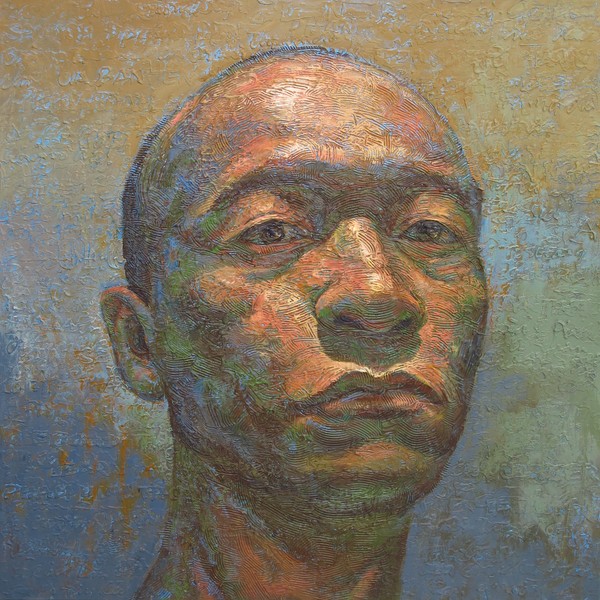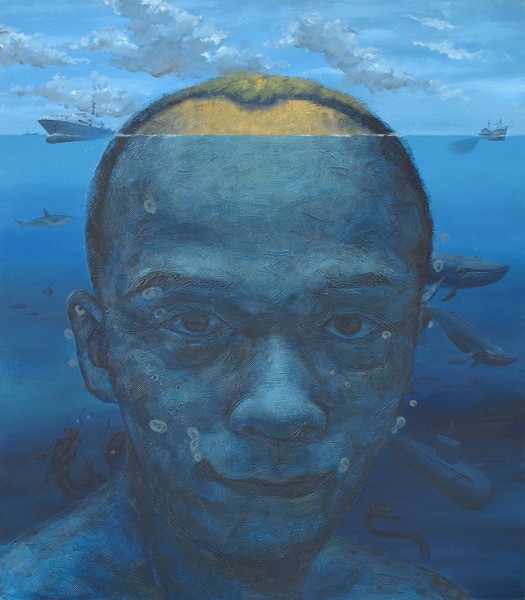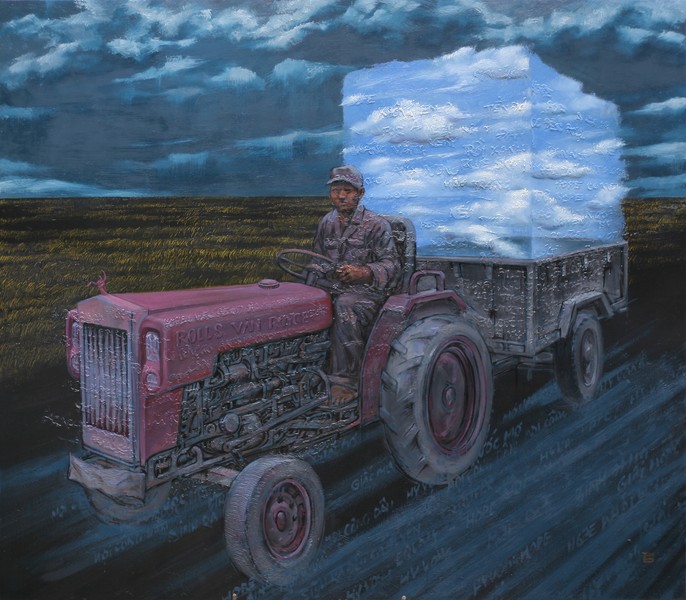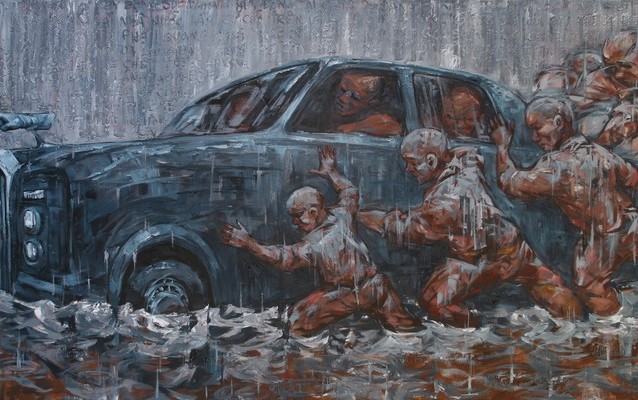Born in 1981 in Ha Tay Province, Pham Huy Thong is a 2004 graduate of the Hanoi Industrial Fine Arts University. Among his many important solo and group exhibitions in Vietnam and abroad, Thong displayed his solo exhibition Hands at Craig Thomas Gallery in November 2012. We posed questions to Thong to better understand what drives this talented, compelling and articulate artist.
What mediums do you work in?
My primary medium is oil but like all artists, who are curious big-children, I keep trying other materials. Lacquer was my first successful medium. It was in 2003 when I first tried lacquer. It is a very complicated medium and without any teacher or tutor I made a lot of mistakes and failures in the first few months. Gradually, when I learned to handle the technique, I found that my lacquer paintings somehow looked very different to other artists’ work. I’m not saying that my technique looked better; it just looked different. But ‘different’ is a very key feature in contemporary art. My lacquer paintings helped me earn a lot of money and gain confidence during my time as a student.

But since I started to develop my paintings with more meaning, stories and thinking, working with lacquer seemed too time-consuming. It’s not fun to have to wait months to find out if an idea worked out well on a lacquer surface so I tried other materials like acrylic, watercolor, ink and oil. Now most of my serious works are done with oil or acrylic while sketches and drawings are usually done in watercolor or with an ink pen on paper.
Sometimes, to express myself differently, I also try to do installations and performances. The process of build up and installation artwork always makes me feel quite excited.
What role do you think an artist should play in society in general, and, in particular, in modern Vietnamese society?
Well, if you had asked me this question seven years ago, my answer would have been very different than it is today. However, I still believe that an artist is not the pioneer of this world (but then again we have never been the ‘leaders’ of anything). If you want to change a country, you’d better go into politics or grab a gun and make a revolution, but if you want to change the long-term future of a country (talking generations), then being an artist is not a bad choice.

Artists and art cannot effect change quickly enough, especially in Vietnam, where art education is not developed, so the majority of people do not understand art. They do not have the right attitude to listen to what an artist is saying. But an artist still has to do an artist’s job, because we are witnesses of our time, and we eternalize what we observe through our expression on canvas (or in our artwork in general).
Of course, art has an impact on society in a very gentle way. If you stand long enough, you can see how art can change this society (as changing art itself). Fifteen years ago, an artist named Truong Tan, a gay man, battled a system of censorship that sought to limit his freedom of expression. His “weird and dirty” paintings which depicted nude men making love were banned. Many of his paintings were taken down at his exhibitions and many related troubles that manifested in his life aimed at slowing down his energetic artistic practice. But Truong Tan’s fight was noticed not only by the local art community but also by the international media and professional art critics. They kept talking about his artworks. Today, Vietnam is the one of the most open countries in the region where we can talk freely about homosexuality. Two years ago, there was a photo exhibition in the Goethe Institut in Hanoi about the lives of gays and lesbians. The photographer – Maika – later on received a big international photo prize because of that. This controversial exhibition would never have taken place without Truong Tan’s fight 15 years prior.

How has your artistic practice evolved since you began your career?
The art that I did in the early stages was simply portraits or self-reflecting paintings. But on the way learning, especially in the period from 2006-2007, I started to try to express my thinking and understanding about some more serious topics such as political or social issues. My first solo exhibition was a one-room installation (2006) that depicted rain and people running underneath it trying to hide themselves from a common threat, instinctively and creatively showing their own individual ways to try and stay dry.
My second solo show was at L’Espace. This second solo show Updated included bi size paintings and an installation. Paintings in the show were all appropriations from Dong Ho traditional prints. The lives depicted in Dong Ho prints were hundreds of years out of date. I took the same composition but recreated them with modern life issues. Mentioning modern life on the foundation of old print, I had chances to criticize current phenomenon in a context of societal history. The Updated series was not my most popular series, but it showed my biggest leap forward, talking about politics and society more directly and wisely.
Do you have professional goals as an artist and do you have an idea of where you would like to be in, say, 20 years?
Of course every artist has a dream to become internationally famous. So do I. As well as trying to make more meaningful art, I am now continuingly trying to build a broader network and collector base abroad But as my paintings mostly talk about Vietnamese issues, I hope that my painting can come to be accepted and be understood by more Vietnamese people.
The audience for visual and contemporary art in Vietnam is currently very small. you can see many familiar faces in all the different exhibition openings. I hope in the next 10 or 20 years, visual art can come to be welcomed by a bigger domestic audience so the amount of ‘famous’ and ‘popular’ artists are closer to each other.
What particular problems or challenges do you see facing Vietnamese art/ artists, and, conversely, what advantages do you see to being an artist in Vietnam at this unique time in the country’s history?
The condition for Vietnamese artists is actually good. We are living right above a gold mine of ‘issues.’ Just wake up every morning, look through your front door to see the street, to hear the noises and you will find a lot of things to complain about. I believe artists who live in more developed countries such as in Northern Europe, for example, do not find that much inspiration easily available.
Of course, people may expect that I should focus my complaints on issues of censorship, free speech, etc. But I have been talking about such things for a long time. Sometimes, I consider those obstacles as easy targets for an artist to fight against I think it would be a big shock for us if tomorrow morning everything turned totally free all of a sudden and we could speak and paint about whatever we liked. I think in that event, I would be mute for a while.
I thing the biggest challenge for artists now as well as in the past are the tendencies to self-censorship and greed. While censorship will try to stop you when you fight, these two things kill all your will to fight before you have ever begun the struggle.
Can you tell us about your Tu Lap Young Talent program and why you think it is incumbent upon successful artists who are moving into mid-career status to support young artists?
I was lucky in 2008 when I received a full sponsorship to travel and see art in other countries. The differences between seeing art through books and computer screens and seeing art directly are indisputable. Traveling to Singapore, China, Thailand to see their art museums, to talk with artists and watch them working expanded my horizons and collapsed all of my old standards for making art.
Now I want to give the same chance to a younger artist. Each year, through an application process, I will select one promising artist to go with me to see Art Stage Singapore for six days. The Asiarta Foundation agreed to support that same artist with a one-month residency in Malaysia. Six days in Singapore and one month in Malaysia would be a good time for the artist to gain exposure to a different cultural environment and to give them a wider imagination of what they can be in the future.

Can you tell us about your upcoming collection Hope?
The Hope series was started in March 2014 and focuses on exploiting theme related to rural farmers and the urban working poor. Vietnam’s process of urbanization and modernization has created an increasing gap between the rich and the poor. Those who have a low position in society are increasingly pushed to the margins. During times of economic crisis, the inequality gap does not shrink but becomes exacerbated.
The Hope paintings exploit the contrast between images of storm clouds representing the uncertain future of the poor and images of white clouds like the hope that rises in their hearts. Although the people who collect my paintings are well off, my intention with this series is not to engender social pity towards the subjects. On the contrary, I hope they will provide a source of encouragement because rich or poor each of us must face and overcome our own problems, something which requires great faith in the future.
Thong’s latest series of paintings entitled Hope will be exhibited at CT Gallery (27i Tran Nhat Duat, D1) in early December 2015.


